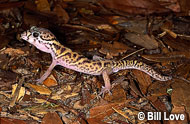Description:
This medium-sized gecko is like the new world’s answer to Asia’s leopard gecko. Although adult Central American banded geckos do not approach the girth and length of leopard geckos, their habits are similar in many other ways. By day the Central American banded gecko prefers to hide in a burrow in the soil. They emerge at dusk to forage for insects that make up the vast majority of their diet. A simple cage substrate of sand and gravel will suffice, with rocks and hollow logs to climb. A small cave or burrow should also be provided at the cool end of the cage. A squirt of water into the shelter every few days will assure that the Central American banded gecko has a moist alcove in the otherwise dry cage setup. Offer six to 10 small insects, each of which is smaller than the Central American banded gecko’s head. If all are consumed immediately, offer additional food sparingly until the Central American banded gecko loses interest in continuing feeding. Never leave surplus insects in the cage that may nibble on the Central American banded gecko during its dormant periods. Handle these Central American banded geckos carefully because their tails may break with rough handling. If an accident occurs, most geckos will regenerate lost tails within a year if healthy.
Habitat:
Mesic woodlands to semi-arid regions
Range:
Central America
Scientific Name: Coleonyx mitratus
Species Group: gecko
Family: Gekkonidae
Size: 4 to 7 inches
Level: beginner
Weight:
Dangerous: No


